 The PRISM group at the University of Washington has created a
high-accuracy DEM of parts of the Skagit Delta and nearby areas,
using 46414 points surveyed by the US Corp of Engineers, and supplied
to the UW Courtesy of Josh Greenberg of Skagit County. The creation
of a regularly spaced elevation grid from scattered survey points
involves a number of arbitrary decisions. The UW takes full
responsibility (but absolutely no liability) for the resulting DEM.
The PRISM group at the University of Washington has created a
high-accuracy DEM of parts of the Skagit Delta and nearby areas,
using 46414 points surveyed by the US Corp of Engineers, and supplied
to the UW Courtesy of Josh Greenberg of Skagit County. The creation
of a regularly spaced elevation grid from scattered survey points
involves a number of arbitrary decisions. The UW takes full
responsibility (but absolutely no liability) for the resulting DEM.
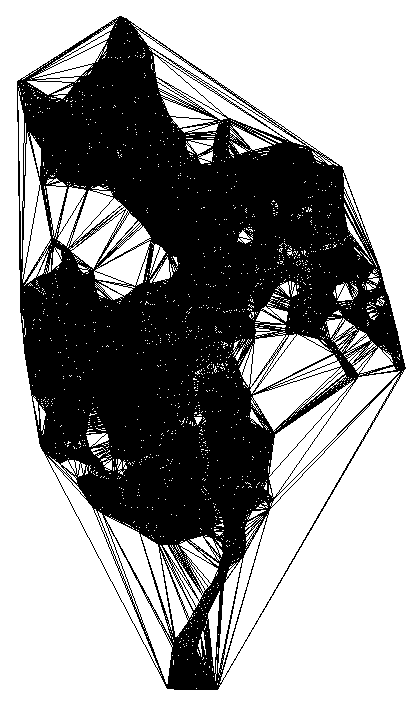 The data points were first imported to ARC/INFO and converted to
a TIN (triangular irregular network). Triangles with an edge length
greater than 500 meters were selected, and this set was edited by
hand. These triangles were used to create a mask within which
interpolation between survey points would not be used at all.
The data points were first imported to ARC/INFO and converted to
a TIN (triangular irregular network). Triangles with an edge length
greater than 500 meters were selected, and this set was edited by
hand. These triangles were used to create a mask within which
interpolation between survey points would not be used at all.
 In places which the DNR hydrology coverage showed as water, the USGS
DEM was given a weight equal to the longest triangle edge divided by
five, plus fifty.
For the remaining area, a weight was assigned to each 10-meter grid
cell, based on the length of the longest edge of the principle tringle
in that grid cell.
In places which the DNR hydrology coverage showed as water, the USGS
DEM was given a weight equal to the longest triangle edge divided by
five, plus fifty.
For the remaining area, a weight was assigned to each 10-meter grid
cell, based on the length of the longest edge of the principle tringle
in that grid cell.
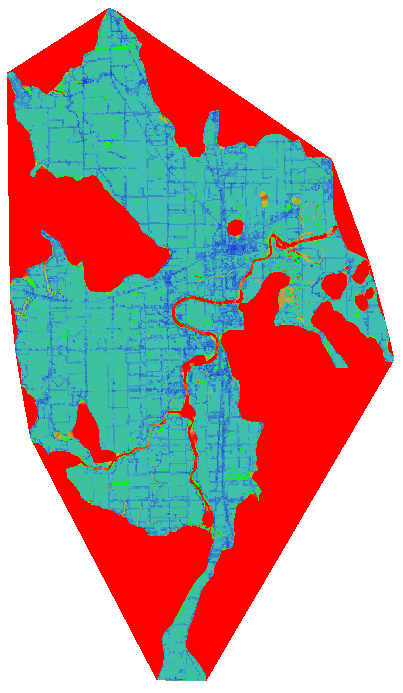 The USGS data was given a weight
equal to the longest edge (in meters) divided by five.
The final DEM
is a weighted average of the USGS 10-meter DEMs and the DEM derived
directly from the TIN, with the weight given to the TIN approaching
zero as the length of triangle edges approaches 500 meters.
The red areas give zero weight to the survey data
and the bluest areas give full weight to survey data. You see that
survey data is densest near roads.
The USGS data was given a weight
equal to the longest edge (in meters) divided by five.
The final DEM
is a weighted average of the USGS 10-meter DEMs and the DEM derived
directly from the TIN, with the weight given to the TIN approaching
zero as the length of triangle edges approaches 500 meters.
The red areas give zero weight to the survey data
and the bluest areas give full weight to survey data. You see that
survey data is densest near roads.
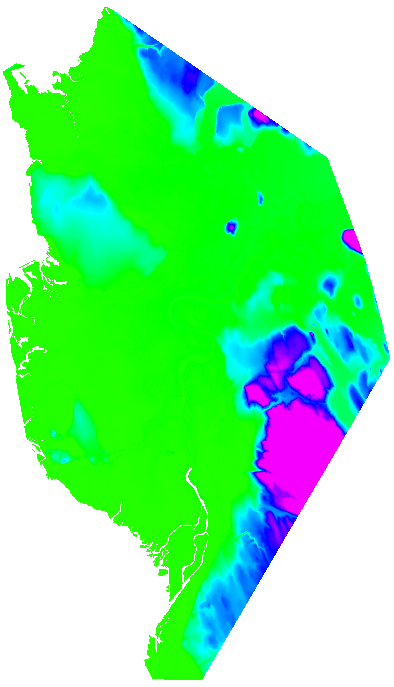 The resulting DEM is more accurate than the USGS DEM, and contains fewer
artifacts. This DEM can be merged with the USGS 10-meter DEM to form a
seamless product.
The resulting DEM is more accurate than the USGS DEM, and contains fewer
artifacts. This DEM can be merged with the USGS 10-meter DEM to form a
seamless product.
 Values range from 18.5 meters higher (bluest) than the USGS DEM to 38.9
meters lower (reddest).
Values range from 18.5 meters higher (bluest) than the USGS DEM to 38.9
meters lower (reddest).
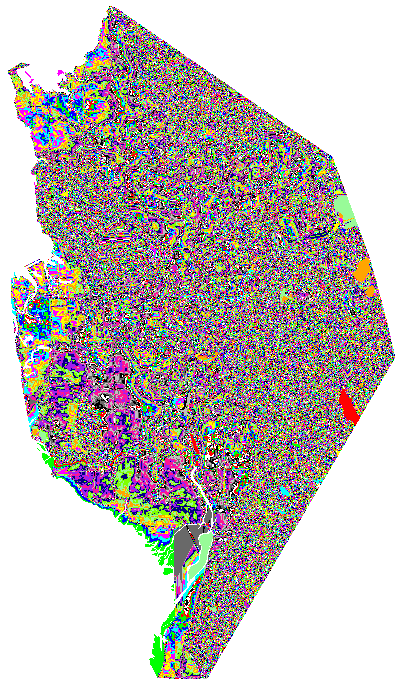 This is an image of the new DEM with the colors repeating in a
cycle of 1.6 meters. It shows a smooth transition between elevations
in most places.
This is an image of the new DEM with the colors repeating in a
cycle of 1.6 meters. It shows a smooth transition between elevations
in most places.
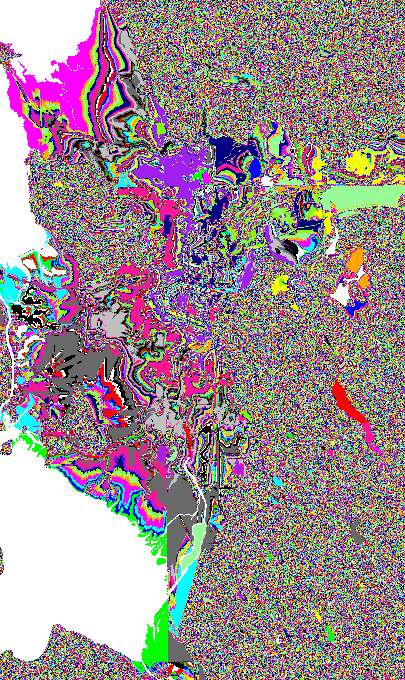 This is a similar image based on the USGS DEM. Many artifact
can be seen here.
This is a similar image based on the USGS DEM. Many artifact
can be seen here.
And here is the data as an ARC/INFO export file.
The Z values are integer decimeters. The projection is UTM zone 10, NAD27.
The e00 file is 127155958 bytes, zipped to 6503389 bytes.
Web Curator: Harvey Greenberg
 The PRISM group at the University of Washington has created a
high-accuracy DEM of parts of the Skagit Delta and nearby areas,
using 46414 points surveyed by the US Corp of Engineers, and supplied
to the UW Courtesy of Josh Greenberg of Skagit County. The creation
of a regularly spaced elevation grid from scattered survey points
involves a number of arbitrary decisions. The UW takes full
responsibility (but absolutely no liability) for the resulting DEM.
The PRISM group at the University of Washington has created a
high-accuracy DEM of parts of the Skagit Delta and nearby areas,
using 46414 points surveyed by the US Corp of Engineers, and supplied
to the UW Courtesy of Josh Greenberg of Skagit County. The creation
of a regularly spaced elevation grid from scattered survey points
involves a number of arbitrary decisions. The UW takes full
responsibility (but absolutely no liability) for the resulting DEM.
 The data points were first imported to ARC/INFO and converted to
a TIN (triangular irregular network). Triangles with an edge length
greater than 500 meters were selected, and this set was edited by
hand. These triangles were used to create a mask within which
interpolation between survey points would not be used at all.
The data points were first imported to ARC/INFO and converted to
a TIN (triangular irregular network). Triangles with an edge length
greater than 500 meters were selected, and this set was edited by
hand. These triangles were used to create a mask within which
interpolation between survey points would not be used at all.
 In places which the DNR hydrology coverage showed as water, the USGS
DEM was given a weight equal to the longest triangle edge divided by
five, plus fifty.
For the remaining area, a weight was assigned to each 10-meter grid
cell, based on the length of the longest edge of the principle tringle
in that grid cell.
In places which the DNR hydrology coverage showed as water, the USGS
DEM was given a weight equal to the longest triangle edge divided by
five, plus fifty.
For the remaining area, a weight was assigned to each 10-meter grid
cell, based on the length of the longest edge of the principle tringle
in that grid cell.
 The USGS data was given a weight
equal to the longest edge (in meters) divided by five.
The final DEM
is a weighted average of the USGS 10-meter DEMs and the DEM derived
directly from the TIN, with the weight given to the TIN approaching
zero as the length of triangle edges approaches 500 meters.
The red areas give zero weight to the survey data
and the bluest areas give full weight to survey data. You see that
survey data is densest near roads.
The USGS data was given a weight
equal to the longest edge (in meters) divided by five.
The final DEM
is a weighted average of the USGS 10-meter DEMs and the DEM derived
directly from the TIN, with the weight given to the TIN approaching
zero as the length of triangle edges approaches 500 meters.
The red areas give zero weight to the survey data
and the bluest areas give full weight to survey data. You see that
survey data is densest near roads.
 The resulting DEM is more accurate than the USGS DEM, and contains fewer
artifacts. This DEM can be merged with the USGS 10-meter DEM to form a
seamless product.
The resulting DEM is more accurate than the USGS DEM, and contains fewer
artifacts. This DEM can be merged with the USGS 10-meter DEM to form a
seamless product.
 Values range from 18.5 meters higher (bluest) than the USGS DEM to 38.9
meters lower (reddest).
Values range from 18.5 meters higher (bluest) than the USGS DEM to 38.9
meters lower (reddest).
 This is an image of the new DEM with the colors repeating in a
cycle of 1.6 meters. It shows a smooth transition between elevations
in most places.
This is an image of the new DEM with the colors repeating in a
cycle of 1.6 meters. It shows a smooth transition between elevations
in most places.
 This is a similar image based on the USGS DEM. Many artifact
can be seen here.
This is a similar image based on the USGS DEM. Many artifact
can be seen here.